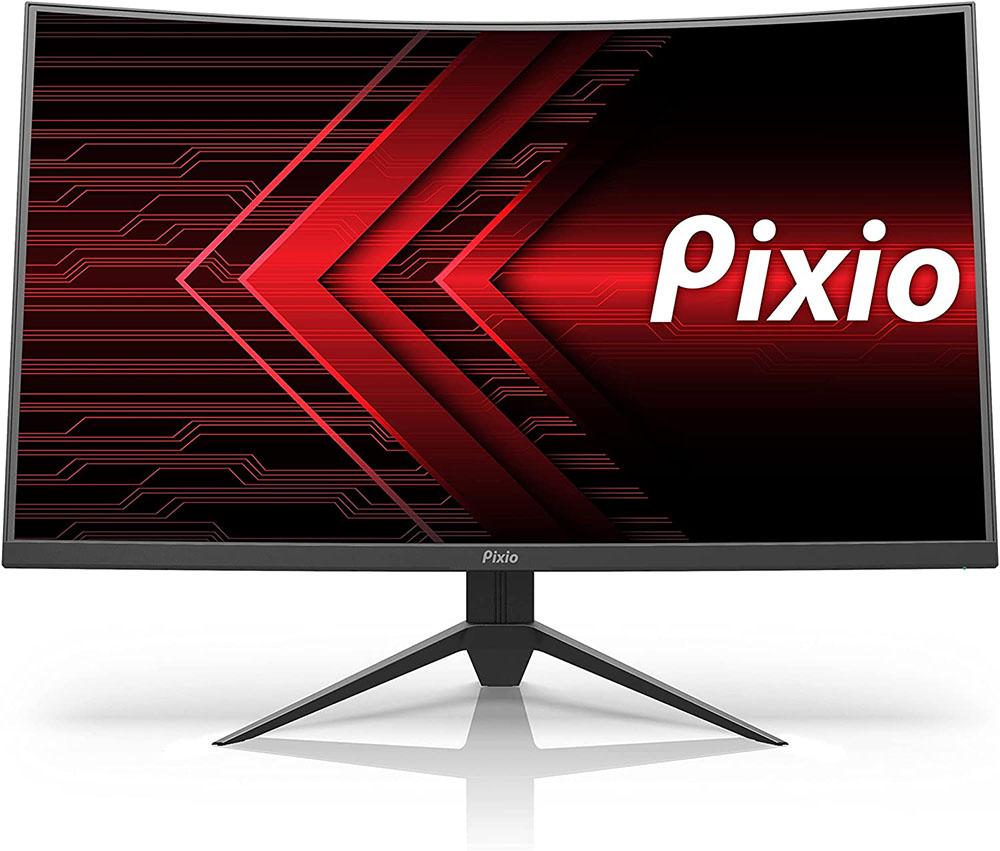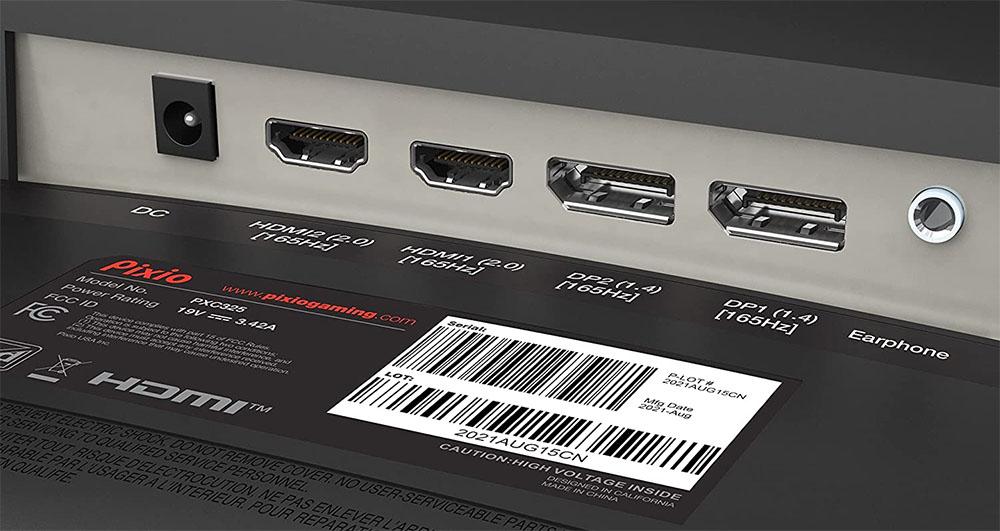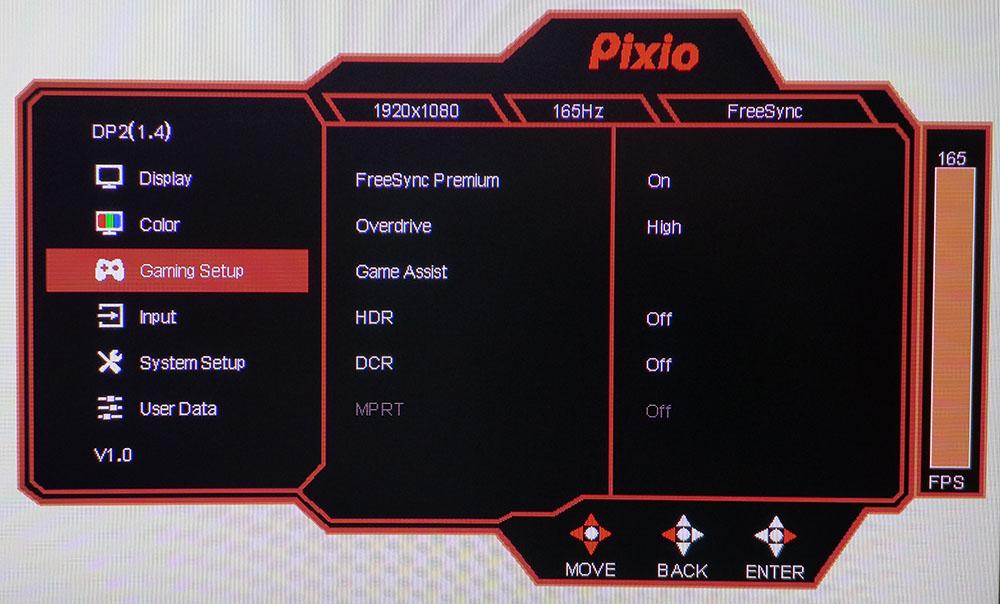Tom's Hardware Verdict
The Pixio PXC325 makes a few sacrifices to achieve a very low price. But with superb contrast and solid color performance, it makes for a very good gaming monitor. With a few tweaks, it delivers a colorful and accurate image that looks realistic with deep blacks and detailed highlights.
Pros
- +
+ Solid gaming performance at high frame rates
- +
+ Excellent contrast
- +
+ Accurate color and gamma with calibration
- +
+ Value
Cons
- -
Weak overdrive
- -
Below average input lag
- -
Little difference between SDR and HDR
Why you can trust Tom's Hardware
Gamers desiring the big screen experience have the inevitable dilemma concerning the size-to-price ratio. For the most part, a larger display costs more money. So, where is the sweet spot? A 32-inch panel is the perfect size for both work and play on my desktop. I can display two documents at once, keep email open while editing an article, or see a large spreadsheet. And gaming is loads of fun when one’s entire peripheral vision fills with a richly-detailed virtual environment.
Available for the impressive price of $270, the Pixio PXC325 features a 32-inch curved FHD VA panel that runs at 165 Hz with Adaptive-Sync, HDR and extended color. Strong contrast and accurate color make the PXC325 a great value, but mediocre overdrive performance and a low-for-the-size 1080p resolution keep it from taking a place among the best gaming monitors.
Pixio PXC325 Specs
| Panel Type / Backlight | VA / W-LED, edge array |
| Screen Size / Aspect Ratio | 32 inches / 16:9 |
| Row 2 - Cell 0 | Curve Radius: 1500mm |
| Max Resolution & Refresh Rate | 1920x1080 @ 165 Hz |
| Row 4 - Cell 0 | FreeSync: 48-165 Hz |
| Row 5 - Cell 0 | G-Sync Compatible |
| Native Color Depth & Gamut | 8-bit (6-bit+FRC) / DCI-P3 |
| Row 7 - Cell 0 | HDR10 |
| Response Time (MPRT) | 1ms |
| Brightness (mfr) | 400 nits |
| Contrast (mfr) | 4,000:1 |
| Speakers | None |
| Video Inputs | 2x DisplayPort 1.4 |
| Row 13 - Cell 0 | 2x HDMI 2.0 |
| Audio | 3.5mm headphone output |
| USB 3.0 | None |
| Power Consumption | 20.3w, brightness @ 200 nits |
| Panel Dimensions WxHxD w/base | 28 x 20.8 x 9.9 inches (711 x 528 x 251mm) |
| Panel Thickness | 4.1 inches (104mm) |
| Bezel Width | Top/sides: 0.3 inch (8mm) |
| Row 20 - Cell 0 | Bottom: 0.8 inch (20mm) |
| Weight | 13 pounds (5.9kg) |
| Warranty | 3 years |
The first thing people will notice is the PXC325’s FHD resolution. It’s unusual to see 1920x1080 on a 32-inch screen. You will see individual pixels at this size if you sit 2 to 3 feet away, but is that a deal-breaker? Not when you consider this panel’s 4,000:1 contrast ratio. The PXC325 delivers deep blacks and a wide dynamic range by using VA technology. This goes a long way to mitigating the effects of its relatively low pixel density.
There’s plenty of color here too, with nearly 87% coverage of DCI-P3 according to our measurements. That color gamut is used for both SDR and HDR content. Though there is an sRGB option in the color temp menu, it does not reduce the size of the color space.
The PXC325 supports HDR10 signals, but there is no dynamic contrast feature in HDR mode (which means no more contrast). HDR images will look much like their SDR counterparts. Additionally, you must manually switch the panel into HDR mode before activating HDR in Windows or your favorite game.
Pixio hasn't sacrificed gaming features to keep the price low. The PXC325 supports both FreeSync and G-Sync, but the monitor has not been certified by Nvidia. You also get a standard suite of play aids that includes a frame rate indicator, aiming crosshairs and a countdown timer. A backlight strobe is also present that can reduce motion blur by inserting a black frame between each active one. The tradeoff is you don’t get Adaptive-Sync, and brightness is reduced by half.
The PXC325 looks like a solid, value-oriented package with decent specs and a very low price given its size. As always, we’ll see how the monitor performs in our tests to see how it compares to its immediate rivals.
Get Tom's Hardware's best news and in-depth reviews, straight to your inbox.
Assembly and Accessories on Pixio PXC325
Pixio is one of the few manufacturers to pack its monitors in flexible foam that doesn’t crumble. The contents are well protected from shock and vibration. The upright and base are mated with two fasteners that require a Phillips-head screwdriver. Then, the panel snaps on to create a solid chassis that is light and free from wobble or play. An external power supply is included, along with a DisplayPort cable.
Product 360: Pixio PXC325



From the front, you can see the Pixio PXC325’s super-thin, flush-mounted bezel that is just 8mm wide. The screen curve isn’t extreme; 1500R is relatively gentle, especially in the 16:9 aspect ratio. It’s enough to wrap the image a little but not so much that there is distortion. It’s a feature that neither detracts from nor enhances the experience.
You can see a few styling cues on the back, including subtle molded-in lines that resemble spaceship hull plating, a common theme for gaming monitors. It’s framed by a chevron-shaped bulge that focuses the eye on the Pixio logo in the center. A 100mm VESA mount is provided but you’ll need your own bolts to use it.
The stand and base are made from solid cast aluminum and finished in Pixio’s signature crinkle coat. The screen sits a little low for my taste, so I had to angle it upward a bit to get comfortable (the only adjustment is 5/15 degrees tilt). My preference for curved monitors is to keep them perfectly vertical. To do this with the Pixio PXC325 would require a pedestal about six inches high.
The input panel has two DisplayPort 1.4, two HDMI 2.0 ports and a 3.5mm audio jack for headphones. There are no USB ports or internal speakers, but you can control volume from the OSD.
OSD Features of Pixio PXC325
The PXC325’s OSD has a gaming style with its beveled corners and control panel shape. It’s divided into six sub-menus and always shows the current refresh rate along with resolution and FreeSync status.
There are seven picture modes of which User is the default and best. Movie and Photo are color accurate, but they and the gaming modes lock out the brightness and contrast controls. Only User lets you control the backlight. Black Equalizer can help bring out shadow detail if the image is too dark. I didn’t need it as the PXC325 has very accurate gamma. I could always make out fine shades of black with no problem. The last two options, Sharpness and Ultra Vivid, add edge enhancement and should be avoided. They create outlines around areas of high contrast that reduce resolution.
The Color menu has a full set of color temp and gamma presets. You can also adjust the hue and saturation of all colors together though I found this unnecessary. However, I did need to perform a calibration. The default grayscale tracking is also very blue in tone.
Gaming features reside in the Gaming Setup menu. You can toggle Adaptive-Sync on or off, set one of three overdrive levels, turn on timers, frame counter or aiming points, and engage HDR and dynamic contrast for SDR material. MPRT is the backlight strobe, and though it does reduce blur, it cuts brightness by half. It’s better to leave it off and stick with Adaptive-Sync.
Calibration Settings for Pixio PXC325
The Pixio PXC325 has accurate color and gamma but is sorely in need of grayscale calibration. The default color temperature is very cool in tone, and you can clearly see a blue tint in all content. I spent some back-and-forth time with the RGB sliders, as they were a bit finicky. In the end, I made a visible improvement in both perception and measured values. I suggest using the settings below to set up your PXC325.
For HDR content, it is necessary to first engage HDR mode in the OSD before loading your game or activating Windows’ HDR. Once done, there are no image controls available, but color is reasonably accurate. I’ll show you those results on page five.
| Picture Mode | User |
| Brightness 200 nits | 35 |
| Brightness 120 nits | 16 |
| Brightness 100 nits | 11 |
| Brightness 80 nits | 7 |
| Brightness 50 nits | 0 |
| Contrast | 50 |
| Gamma | 2.2 |
| Color Temp User | Red 50, Green 50, Blue 46 |
Gaming and Hands-on With Pixio PXC325
It’s inevitable that low pixel density will be the first concern potential buyers have about the Pixio PXC325. At 32 inches, the 1080p resolution gives you 70 pixels-per-inch, but is that enough? In my experience, yes, it is. I won’t say that I was fooled into thinking it was a QHD monitor, but its superb contrast eliminated any concerns I had.
In Windows, small fonts and graphics are perfectly readable up close using 100% font scaling. I could see slight jaggies on a few tiny letters, but I never had trouble discerning the smallest text. Graphics were well detailed, perhaps a bit softer than a QHD or UHD monitor would be, but still sharp. The 4,100:1 contrast really makes a difference, as an IPS or TN screen of this size and resolution would not look as good.
Trying HDR in Windows for productivity proved disappointing. After switching on the menu option, I made the change in Control Panel and was greeted with a washed-out image. There are some tweaks available (in Control Panel, not the PXC325), but I didn’t find HDR beneficial for workday tasks.
Turning to Doom Eternal, I compared SDR and HDR and found differences, but again, no benefit to using HDR. I had to make several adjustments in the game’s menu to keep both shadow and highlight detail from disappearing altogether. The extra pop of color was nice but, in the end, I preferred the SDR version of the game.
That color was presented in all its warm and fiery shades with great depth and contrast. Reds were flaming, greens were lush and blue, well, there aren’t a lot of cool tones in a game like Doom Eternal. It looked great with solid detail.
My only complaint was a weak overdrive. No matter which setting I chose, it allowed some blur to creep in. It didn’t distract during intense battles, but it was visible when exploring the environment. Using MPRT didn’t help much, and since I didn’t want to give up Adaptive-Sync, I left it off after a brief test. Overall motion processing was just fair.
I had no trouble keeping frame rates at 165 fps. FreeSync and G-Sync worked equally well on AMD and Nvidia platforms, respectively. The main benefit of FHD resolution is that high speeds are easy to achieve. You won’t need a super-expensive video card to use the Pixio PXC325’s full potential.
I also made the SDR to HDR comparison in Call of Duty WWII. There, I preferred SDR because its shadow areas were far more realistic. Even with some tweaking in the game’s menu, I couldn’t get HDR black levels below a dark gray. The SDR blacks were deeper. The PXC325’s HDR quality is clearly game-dependent. Some titles will look fine in HDR and some will be better in SDR mode.
The general takeaway from my gaming and hands-on use of the Pixio PXC325 was positive. It’s a good-looking big screen monitor that delivers more than expected for the price.
Current page: Features and Specifications
Next Page Response, Input Lag, Viewing Angles and Uniformity
Christian Eberle is a Contributing Editor for Tom's Hardware US. He's a veteran reviewer of A/V equipment, specializing in monitors. Christian began his obsession with tech when he built his first PC in 1991, a 286 running DOS 3.0 at a blazing 12MHz. In 2006, he undertook training from the Imaging Science Foundation in video calibration and testing and thus started a passion for precise imaging that persists to this day. He is also a professional musician with a degree from the New England Conservatory as a classical bassoonist which he used to good effect as a performer with the West Point Army Band from 1987 to 2013. He enjoys watching movies and listening to high-end audio in his custom-built home theater and can be seen riding trails near his home on a race-ready ICE VTX recumbent trike. Christian enjoys the endless summer in Florida where he lives with his wife and Chihuahua and plays with orchestras around the state.


